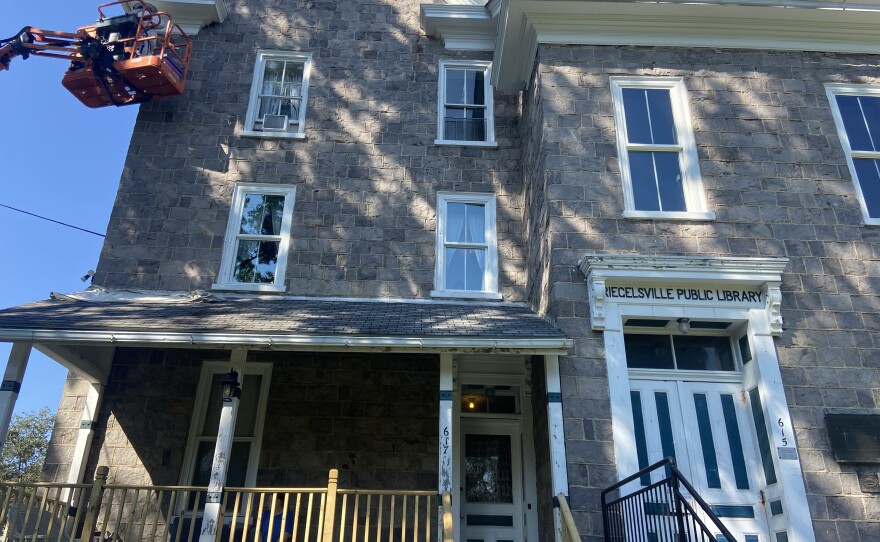- A colony of honeybees was removed from borough hall in Riegelsville
- Beekeeper and carpenter James Zdepski removed them and relocated the bees to a new area
- Last winter was especially deadly for honeybees in the U.S.
RIEGELSVILLE, Pa. — James Zdepski knew what he’d find Wednesday morning when he removed part of the roof of borough hall, revealing tens of thousands of honeybees.
“These are local — they’ve survived five years here,” said Zdepski, a beekeeper and carpenter. “ … I know what I’m going to find here is going to be a strong, vibrant colony, because I have the original queen in my bee yard.
“This is her daughter.”
It’s the second time Zdepski removed honeybees from the borough property this year, after successfully moving a colony, with its queen, in the spring.
After stretching a cherry picker loaded with a smoker, boxes, frames and tools to the third floor, he carefully cut out pieces of roof to reveal more than a dozen combs. After the bees were removed, they were taken to a new home several miles away from borough hall to discourage their return.
“In April, there was a swarm, right here in this bush,” Zdepski said, pointing to a shrub a few yards away from the building, which serves as both the borough hall and library. “The way they reproduce as a superorganism is they divide their colony.
“They’ll send the queen out with up to 70% of the bees, and they’ll find a new home — they’ll start a new colony. They’ll only do that when they’re healthy and strong.”
Zdepski uses the smoker to calm the bees after removing parts of the roof to reveal the comb. pic.twitter.com/QtiOvcSMhM
— Molly Bilinski, artisanal sentence crafter (@MollyBilinski) September 6, 2023
Mites, disease and colony collapse
Brought to the U.S. by European colonists, honeybees are used today for a variety of tasks and products, from pollination to wax and honey. However, continuing threats to honeybees include mites, diseases and colony collapses.
Nearly 90% of the world’s wild flowering plant species depend entirely, or at least in part, on animal pollination, along with more than 75% of the world’s food crops and 35% of global agricultural land.The United Nations
“Nearly 90% of the world’s wild flowering plant species depend entirely, or at least in part, on animal pollination, along with more than 75% of the world’s food crops and 35% of global agricultural land,” according to the United Nations. “Not only do pollinators contribute directly to food security, but they are key to conserving biodiversity.”
Currently, extinction rates in pollinator species, which includes bees but also butterflies, bats and hummingbirds, are 100 to 1,000 times higher than normal due to human impacts, U.N. officials said.
Last winter was especially deadly for honeybees in the U.S. — the second highest death rate on record.
Beekeepers across the country lost 48% of managed colonies, according to an annual survey from Bee Informed Partnership, a nonprofit organization that works to improve honeybee health.
However, even with the steep loss, researchers found the number of honeybee colonies “remained relatively stable.” This most recent loss is not as high as the 50.8% mortality rate from the 2020-2021 season.
The most prominent cause of colony death reported by beekeepers over the winter was “varroa,” according to the report. Called varroa destructor, the mite attacks and feeds on the honeybees.
“Backyard beekeepers then tended to cite ‘adverse weather’ and ‘starvation’ (meaning lack of honey, nectar or sugar water) as the second- and third-most prominent causes of winter colony loss in their operations,” according to the report. “Sideline beekeepers equally cited ‘queen issues’ and ‘starvation’ as their second most prominent cause of winter loss.
“Commercial beekeepers cited equally ‘queen issues’ and ‘adverse weather.’”
‘Fascinating creatures’
Zdepski started beekeeping five years ago. While he grew up around bees, working with them alongside his father, he took a break from the hobby when he took up other interests.
“In five years, I’ve gone from two colonies to 65,” he said. “They’re just fascinating creatures.
“My whole goal is to raise bees to sell bees — not to sell honey, honey is a byproduct — because there’s a shortage of bees due to colony collapse disorder and things like that.”
Zdepski treats his bees with oxalic acid, which coats the hive and kills the mite without harming the bees.
“I had 31 hives going into winter, last winter,” he said. “And I got 31 hives through … If you keep them healthy, they’ll keep reproducing.”
Currently, he has 65 hives, he said.
Hi neighbors , I wanted to update you about the Mount Joy Honey Hut. This morning we bottled some of the honey from the...
Posted by James Zdepski on Saturday, July 15, 2023
Zdepski has a bee yard about a mile away “as the bee flies,” he said. To avoid the colony returning to borough hall, he took them to a yard 14 miles away from borough hall.
“They forage in about a 3-mile radius,” he explained. “ … I’ll take them there for about three weeks, let them reorient there — reset their GPS, so to speak — and then I’ll bring them back to my place.”
After cutting some of the roof’s woodwork free, the entire colony was exposed from underneath, allowing Zdepski to carefully remove combs before securing them inside frames and layer them in a bee box.
“They’re not going to be happy with me,” Zdepski said. “They’re going to send some guard bees out, ‘Who the heck is knockin' on our door — tearing our house open?’”














